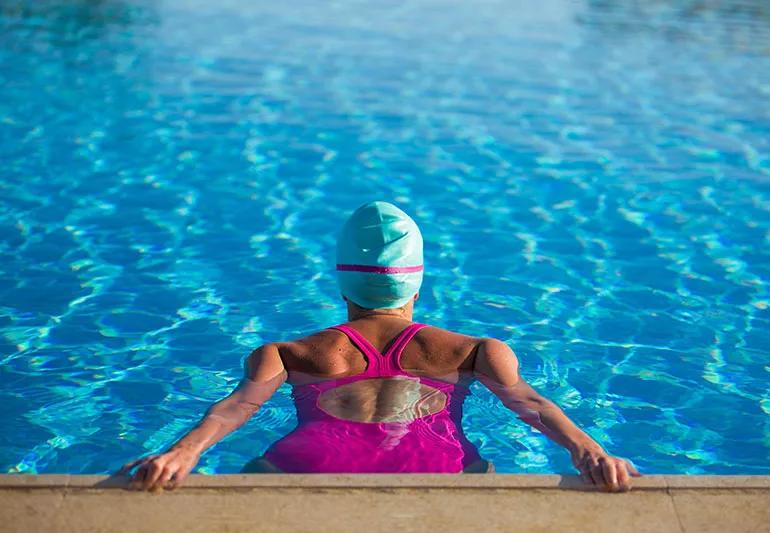Physical activity and weight management can minimize your chances of getting the disease

When it comes to the benefits of regular exercise, here’s one you might not realize: Exercising can reduce your risk of developing breast cancer — and that’s a fact that’s especially true as you age.
Advertisement
Cleveland Clinic is a non-profit academic medical center. Advertising on our site helps support our mission. We do not endorse non-Cleveland Clinic products or services. Policy
Research consistently shows the protective effect of physical activity when it comes to breast cancer. A review of 73 studies found an average risk reduction of 25% for those who work to stay fit.
And if you do get breast cancer, regular exercise before and after the diagnosis minimizes the chances of a recurrence or a deadly outcome.
Need more incentive to start a regular workout routine? Then let’s take a closer look at the relationship between exercise and breast health with oncologists Halle Moore, MD, and Tiffany Onger, MD.
Weight management is a definite perk of physical activity — which brings us to how exercise minimizes breast cancer risk, particularly for postmenopausal women.
Studies show that carrying extra pounds or having obesity brings a significant increase in breast cancer risk for women after menopause. One study showed that a 20-pound weight gain during menopause led to an 18% higher risk of breast cancer.
A variety of factors, including decreases in estrogen production and a slower metabolism, make weight gain common during menopause.
“Being in a higher weight category increases your risk for breast cancer as you age,” says Dr. Onger. “If you’re carrying more fat within your body can affect hormones that are circulating and the growth of cancer cells.”
Advertisement
So, if you reduce body fat (particularly in your midsection), you also reduce your risk of breast cancer. In fact, one study found that losing four to 20 pounds lowered breast cancer risk by 10% to 15%. A 20-pound drop in weight lowered the risk by about 25%.
Health experts generally recommend getting at least 150 minutes of moderate-intensity exercise per week. That’s a 30-minute activity five days a week. (To put the workout in perspective, at “moderate” intensity you should be able to carry on a conversation without gasping for breath.)
But when it comes to warding off breast cancer, researchers say more exercise may be even better, adds Dr. Moore.
A 2015 study showed that exercising for 300 minutes a week — which amounts to five one-hour activity periods a week — led to larger decreases in body fat and a subsequent drop in breast cancer risk.
“But this doesn’t mean you need to become a gym rat,” says Dr. Onger. “Just being more active can bring really positive results.”
If you’re looking to lower your breast cancer risk through exercise, doing so may be as simple as trying activities such as:
If you’re new to fitness and feel overwhelmed by the idea of starting up a program, be patient and give yourself time.
“Slowly incorporate exercise into your weekly routine, starting with a reasonable amount you can build on,” advises Dr. Moore. “Eventually, you should be able to incorporate some type of physical activity into every day.”
It’s always a good idea to talk to your healthcare provider before starting an exercise program, too.
Can exercising regularly guarantee that you won’t get breast cancer? Unfortunately, the answer to that question is no. Activity and fitness merely reduce risk while making you a healthier person.
But if you get breast cancer despite being a workout warrior, know that exercise can help with your recovery. An analysis of studies showed that physical activity after diagnosis was associated with:
The connection once again centers largely on weight management and the health benefits that come with a leaner body. “People don’t always like to talk about weight, but it’s important,” states Dr. Onger.
Advertisement
Breast cancer ranks as the most common cancer in the world. On average, 1 out of 8 women will be diagnosed with breast cancer during their lifetime.
There’s no question that exercise can minimize your risk of getting the disease (or help with recovery after a diagnosis).
“When it comes to breast cancer, there are modifiable risk factors — or things you can do to reduce your risk,” encourages Dr. Onger. “Physical activity and weight management are at the top of that list.”
Advertisement
Learn more about our editorial process.
Advertisement

Breast cancer’s growth rate depends on its type, stage, grade and more

Breast cancer typically spreads to your lymph nodes first, and can travel to your lungs, bones and more

Many breast cancer survivors have babies — talk to your provider before treatment to understand all of your options

A second opinion can confirm your diagnosis and treatment plan and help you feel more confident about what’s next

HER2-low is less aggressive than HER2-positive and HER2-negative, but the new designation allows for targeted therapies that may be helpful

Taking care of yourself extends beyond symptom management and includes things like passion projects and meaningful moments

Support groups, financial assistance and survivorship programs are all readily available

It depends on factors like the stage of the cancer, your age and other risks

The best parenting style balances enforcing rules and showing plenty of love

Tips include cutting back on sugar, focusing on exercise and managing stress

It can be harder to let go when you’ve invested time, energy and emotions — but it might be the healthier choice long term